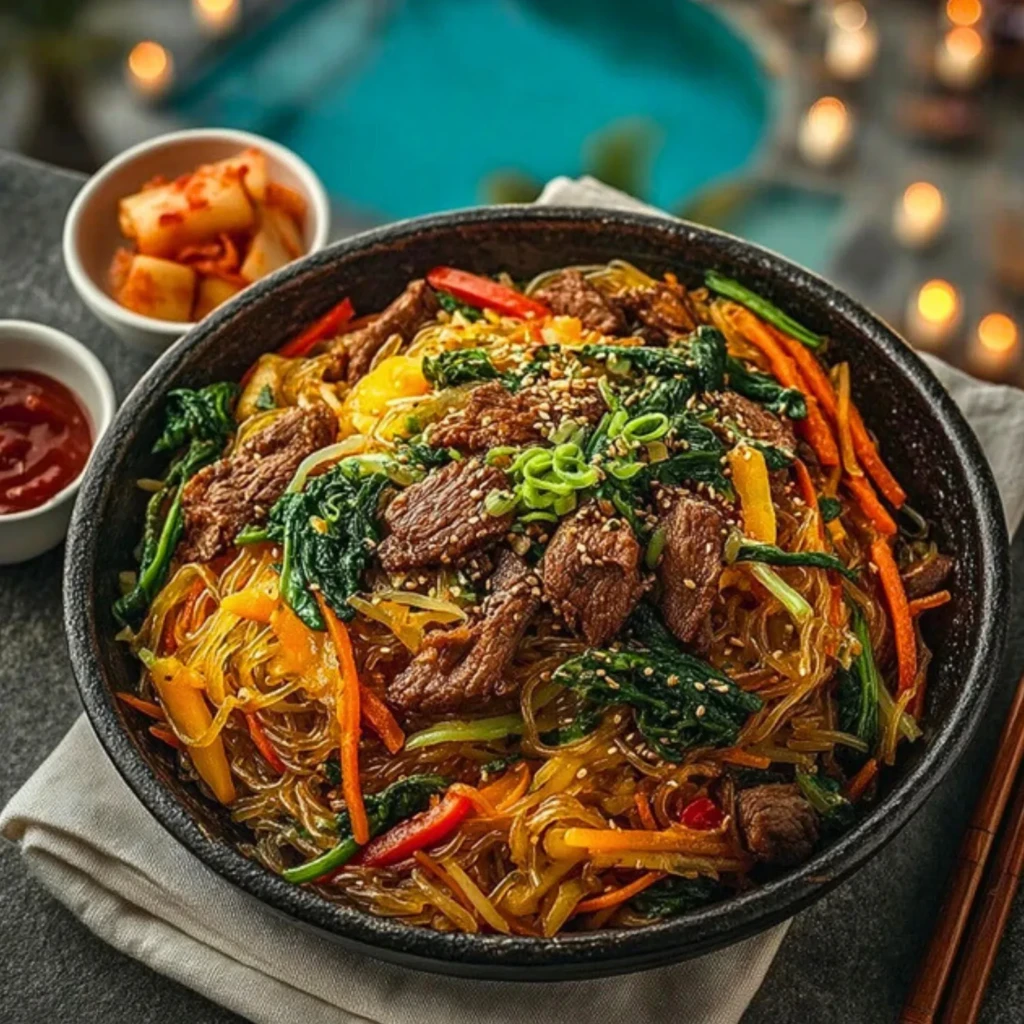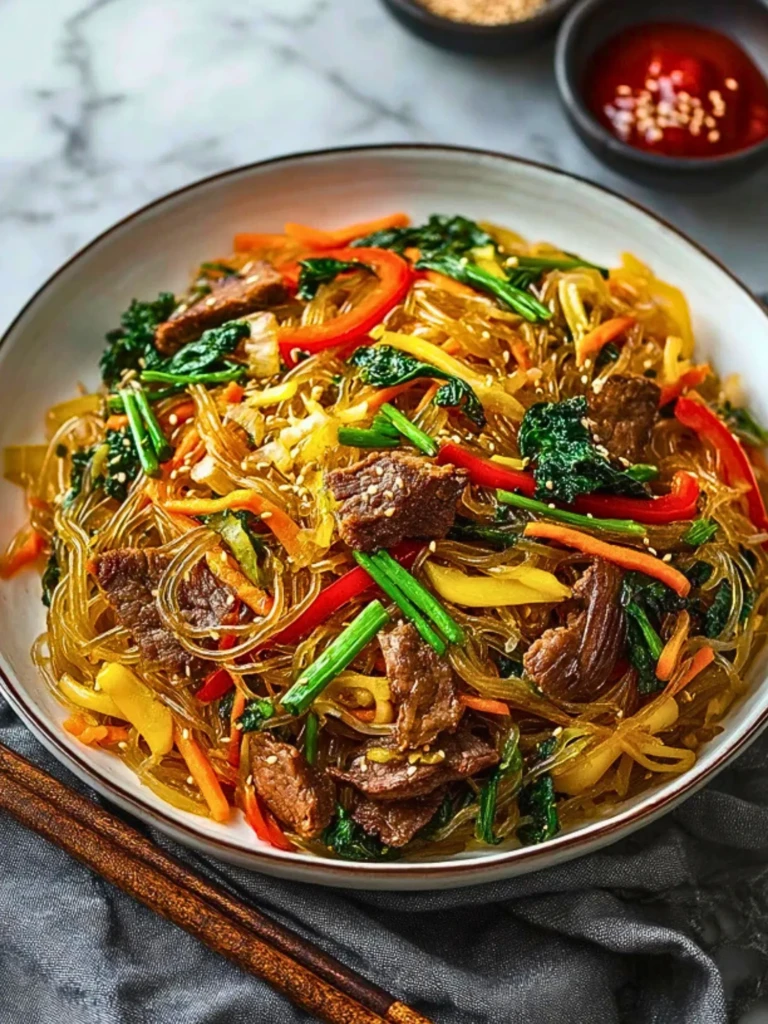Japchae is a colorful and savory Korean dish that beautifully combines chewy glass noodles, crisp-tender vegetables, and marinated beef, all stir-fried together in a slightly sweet, soy-based sauce. Traditionally served during celebrations and holidays, Japchae has earned a spot as one of Korea’s most beloved comfort foods—and it’s easy to see why. Every bite delivers a perfect harmony of textures and flavors.


This dish offers an incredibly satisfying experience: slippery sweet potato noodles absorbing the rich umami of the beef, the crunch of stir-fried vegetables, and just enough sweetness to keep you going back for more. Whether you’re cooking for family, hosting a dinner party, or meal-prepping for the week, Japchae fits beautifully into any occasion.
Why You’ll Love This Japchae
Japchae is both hearty and healthy. It’s gluten-free thanks to the sweet potato starch noodles and packs a rainbow of vegetables that bring both nutrients and crunch. The savory-sweet marinade for the beef seeps into every component, making each bite deeply flavorful. You can also easily adapt this dish for vegetarians by skipping the meat and adding tofu or more mushrooms. Versatile, visually stunning, and crowd-pleasing—Japchae has all the makings of a go-to meal.
What Kind of Noodles Should I Use for Japchae?
The key to Japchae’s signature chewiness is in the noodles. Korean glass noodles, also known as dangmyeon, are made from sweet potato starch and can be found in Asian supermarkets or online. They become translucent and delightfully springy when cooked. Don’t try to substitute them with rice noodles or other types—you’ll miss out on the authentic texture that makes Japchae special.
Ingredients for the Japchae
Each ingredient in Japchae plays an important role in creating the balance of flavor and texture this dish is known for.
- Sweet potato glass noodles (Dangmyeon) – These chewy, translucent noodles are the heart of Japchae.
- Beef (ribeye or sirloin, thinly sliced) – Marinated beef brings a savory, umami richness.
- Carrots – Adds color and a slight sweetness with a satisfying crunch.
- Spinach – Offers vibrant color and a tender, slightly earthy flavor.
- Bell peppers (red and yellow) – Bring brightness, sweetness, and visual appeal.
- Onion – Adds aromatic depth and a touch of sweetness when sautéed.
- Garlic – Essential for building flavor in both the beef marinade and vegetables.
- Soy sauce – The backbone of the seasoning, providing saltiness and umami.
- Sesame oil – Adds nutty aroma and depth, used both in cooking and finishing.
- Sugar – Balances the saltiness and enhances the natural flavors of the ingredients.
- Sesame seeds – Sprinkled on top for added texture and toasty flavor.
- Green onions – Used as garnish for a fresh bite and pop of color.
How To Make the Japchae
Step 1: Prep the Ingredients
Thinly slice all vegetables and beef. Soak the sweet potato noodles in warm water for 20-30 minutes or boil them for 6-7 minutes until tender but bouncy. Drain and rinse with cold water.
Step 2: Marinate the Beef
Combine sliced beef with soy sauce, garlic, sugar, and sesame oil. Let it marinate for at least 15 minutes.
Step 3: Cook Each Vegetable Separately
In a large pan, stir-fry carrots, onions, bell peppers, and spinach individually with a light drizzle of oil and a pinch of salt. This keeps their flavors distinct and vibrant.
Step 4: Stir-Fry the Beef
In the same pan, cook the marinated beef until it’s nicely browned and cooked through. Set aside.
Step 5: Stir-Fry the Noodles
Add the cooked noodles to the pan with soy sauce, a bit more sugar, and sesame oil. Toss until well coated and warm.
Step 6: Combine Everything
Return all cooked vegetables and beef to the pan with the noodles. Toss everything together until evenly mixed. Taste and adjust seasoning if needed.
Step 7: Garnish and Serve
Sprinkle sesame seeds and chopped green onions on top before serving.

How to Serve and Store Japchae
Japchae can be served hot, at room temperature, or even chilled, making it one of the most flexible dishes to enjoy. It’s perfect for lunch boxes, party platters, or quick weekday meals. This recipe makes enough to feed about 4 people generously, but you can easily scale it up for gatherings.
To store leftovers, place the cooled Japchae in an airtight container and refrigerate for up to 4 days. Reheat gently in a skillet with a splash of water or sesame oil to revive the noodles without drying them out.
What to Serve With Japchae?
Steamed White Rice
Simple and soft, white rice makes a great neutral base to enjoy alongside Japchae.
Kimchi
The fermented tang and spice of kimchi provide a sharp contrast to the sweet and savory noodles.
Korean Fried Chicken
Crispy, juicy, and often spicy, Korean fried chicken pairs perfectly for a more indulgent meal.
Miso Soup
Though Japanese in origin, its lightness complements the heartiness of Japchae nicely.
Pickled Radish
Crunchy and tangy, these offer a refreshing palate cleanser.
Korean Pancakes (Pajeon)
Savory pancakes with green onions or seafood add another layer of flavor and texture.
Bulgogi
Pair Japchae with bulgogi for a rich, beefy duo that can easily feed a crowd.
Cucumber Salad
A lightly dressed cucumber salad brings a cooling balance to the warm, stir-fried noodles.
Frequently Asked Questions
Can I make Japchae vegetarian or vegan?
Absolutely! Just omit the beef and add tofu or extra mushrooms like shiitake or oyster for that umami punch. Use a plant-based soy sauce and you’re good to go.
What if I can’t find sweet potato noodles?
They’re key to the texture, but in a pinch, you could substitute with mung bean noodles or even cellophane noodles. Just keep in mind the texture won’t be quite the same.
Can Japchae be made ahead of time?
Yes! Japchae actually tastes better after it sits for a while. You can make it the day before and store it in the fridge. Just warm it slightly before serving or enjoy cold.
How do I prevent the noodles from sticking?
After cooking, rinse the noodles under cold water and toss them with a small drizzle of sesame oil to keep them from clumping.
Is Japchae gluten-free?
Yes, if you use gluten-free soy sauce. The noodles are naturally gluten-free since they’re made from sweet potato starch.
Save This Pin For Later
📌 Save this recipe to your Pinterest dinner board so you can come back to it any time.
And let me know in the comments how yours turned out. Did you go meatless or add more spice? Maybe you tried it with tofu or added shiitake mushrooms?
I love hearing how others make these recipes their own. Questions are welcome too—let’s help each other cook better, one dish at a time.
You can also find more of my daily recipes and food ideas on my Life With Livia Pinterest.
Conclusion
Japchae is the kind of dish that captures everything we love about Korean cooking: balance, depth, color, and comfort. Whether you’re making it for a special occasion or as a weekly staple, it’s sure to bring smiles to the table. With its rich, chewy noodles and flavorful mix of vegetables and beef, it’s a complete meal that you’ll return to again and again.

Japchae: Stir-fried Glass Noodles with Vegetables and Beef
- Total Time: 35 minutes
- Yield: 4 servings
Description
If you’re looking for a colorful, flavorful, and satisfying Korean dish, Japchae is the one! This easy dinner option features chewy sweet potato noodles stir-fried with vibrant vegetables and tender marinated beef. Whether you’re planning quick meals, searching for healthy food ideas, or need a dish to impress at a gathering, Japchae is an easy recipe packed with umami, perfect for lunchboxes or party platters. It’s also naturally gluten-free and easy to make vegetarian.
Ingredients
200g sweet potato glass noodles
200g ribeye or sirloin beef, thinly sliced
1 medium carrot, julienned
1 cup spinach
1 red bell pepper, thinly sliced
1 yellow bell pepper, thinly sliced
1 small onion, thinly sliced
2 cloves garlic, minced
4 tablespoons soy sauce
2 tablespoons sesame oil
1 tablespoon sugar
1 tablespoon sesame seeds
2 green onions, sliced thin (for garnish)
Instructions
1. Soak the sweet potato noodles in warm water for 20–30 minutes or boil for 6–7 minutes. Drain and rinse with cold water.
2. Marinate the beef with 2 tablespoons soy sauce, 1 clove garlic (minced), 1 teaspoon sugar, and 1 tablespoon sesame oil. Let sit for 15 minutes.
3. Stir-fry the carrots, spinach, onions, and bell peppers separately in a pan with a small amount of oil and a pinch of salt. Set aside.
4. In the same pan, stir-fry the marinated beef until browned and cooked through. Set aside.
5. Stir-fry the noodles in the pan with 2 tablespoons soy sauce, 1 tablespoon sugar, and 1 tablespoon sesame oil until well coated.
6. Combine the noodles with all cooked vegetables and beef. Toss together over medium heat.
7. Garnish with sesame seeds and sliced green onions before serving.
Notes
Slice vegetables and beef uniformly for even cooking and presentation.
Don’t skip stir-frying each vegetable separately—it preserves their individual textures and flavors.
For a vegetarian version, substitute beef with tofu or shiitake mushrooms.
- Prep Time: 20 minutes
- Cook Time: 15 minutes
- Category: Dinner
- Method: Stir-fry
- Cuisine: Korean
Nutrition
- Serving Size: 1 bowl
- Calories: 410
- Sugar: 7g
- Sodium: 620mg
- Fat: 14g
- Saturated Fat: 3g
- Unsaturated Fat: 9g
- Trans Fat: 0g
- Carbohydrates: 55g
- Fiber: 4g
- Protein: 18g
- Cholesterol: 35mg
Keywords: Japchae, glass noodles, Korean dinner, easy dinner, quick meals, healthy dinner, beef noodles





